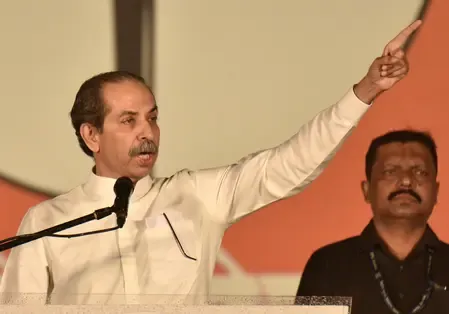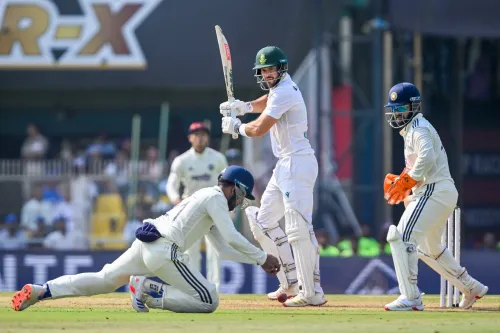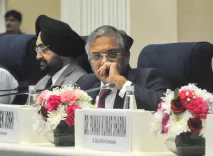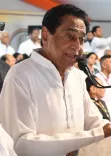Is the NDA's Choice Leaving the INDIA Bloc on Uneven Ground in the Vice-Presidential Race?

Synopsis
Key Takeaways
- C.P. Radhakrishnan’s nomination signifies the NDA's strategic focus on southern India.
- The Electoral College plays a crucial role in determining the outcome of the Vice Presidential election.
- Radhakrishnan's connections may influence voting dynamics within the INDIA bloc.
- The nomination highlights the BJP's intent to bridge regional divides.
- The upcoming election is a platform for potential political realignments.
New Delhi, Aug 17 (NationPress) With the announcement of Maharashtra Governor C.P. Radhakrishnan as the National Democratic Alliance’s candidate for Vice President, the Bharatiya Janata Party has executed a strategic maneuver that merges robust electoral calculations with an intricate regional approach.
This nomination serves not only as a mark of loyalty but also underscores the BJP's renewed ambition to enhance its presence in Tamil Nadu and other southern states, where it has faced historical challenges.
From a numerical perspective, the NDA enters the Vice Presidential race with a distinct edge. The Electoral College consists of 786 members from both Lok Sabha and Rajya Sabha.
Holding 293 Lok Sabha seats and 129 in Rajya Sabha—including the backing of nominated members—the NDA possesses around 422 votes, exceeding the 394 votes required for victory.
On the other hand, the Indian National Developmental Inclusive Alliance (INDIA) bloc has roughly 300 members across both Houses. Even with a unified candidate, the expected margin is likely to be slimmer compared to prior contests.
In the previous elections of 2017 and 2022, M. Venkaiah Naidu and Jagdeep Dhankhar triumphed by 272 and 346 votes, respectively.
While the margin may tighten in the forthcoming contest, the odds seem to favor the NDA.
Non-aligned parties such as the Biju Janata Dal (BJD), Yuvajana Shramika Rythu Congress Party (YSRCP), and Bharat Rashtra Samithi (BRS)—which have previously backed NDA candidates based on individual merit—could potentially lift Radhakrishnan’s vote count again.
However, the BJD has indicated it may withhold support from the NDA this time, citing insufficient consultation.
Importantly, Radhakrishnan’s established relationships with several southern politicians might sway some INDIA bloc members from the region to cross-vote or abstain, subtly altering the vote dynamics in his favor.
This possible shift in allegiance highlights the importance of Radhakrishnan’s personal and political history, deeply embedded in Tamil Nadu’s socio-political environment.
Born as Chandrapuram Ponnusamy Radhakrishnan in Tiruppur, Tamil Nadu, his political journey commenced at the age of 16 with the Rashtriya Swayamsevak Sangh and the Bharatiya Jan Sangh.
He represented Coimbatore in Lok Sabha during 1998 and 1999, and served as BJP’s Tamil Nadu state president from 2004 to 2007.
His 93-day “Rath Yatra” across the state, advocating river-linking and social equity, earned him grassroots credibility and the nickname “Modi of Tamil Nadu”.
In 2004, he strongly asserted that the BJP had neither betrayed any allies nor disrupted political partnerships.
After the Dravida Munnetra Kazhagam’s departure from the BJP-led National Democratic Alliance, Radhakrishnan was pivotal in restoring coalition strength within the Tamil Nadu unit.
He played a key role in forging a new alliance with the All India Anna Dravida Munnetra Kazhagam ahead of the 2004 general elections.
In the 2014 Lok Sabha elections, Radhakrishnan contested from Coimbatore as the BJP candidate.
Despite lacking support from Tamil Nadu’s major parties—the Dravida Munnetra Kazhagam and the All India Anna Dravida Munnetra Kazhagam—he garnered 389,701 votes, finishing as the runner-up.
His tally was the highest among all BJP candidates in the state, and he lost by the narrowest margin recorded across Tamil Nadu that year.
His administrative experience includes gubernatorial roles in Jharkhand (from February 2023 to July 2024), Maharashtra (from July 2024), along with additional responsibilities in Telangana and Puducherry.
He has also represented India at the United Nations and was part of the inaugural parliamentary delegation to Taiwan in 2014. The INDIA bloc is anticipated to announce its candidate shortly, but internal coordination issues and previous abstentions—such as the Trinamool Congress’ decision to abstain in 2022—could weaken its challenge. Nevertheless, the opposition is likely to contest to maintain political relevance.
Ultimately, C.P. Radhakrishnan’s nomination transcends mere numbers—it conveys a message.
It reflects the BJP’s intent to elevate southern leadership, reward loyalty, and symbolically bridge the North-South divide in national politics.
The translation of this into electoral success for the BJP in Tamil Nadu remains uncertain, yet the Vice Presidential race has already evolved into a platform for significant political realignments.









